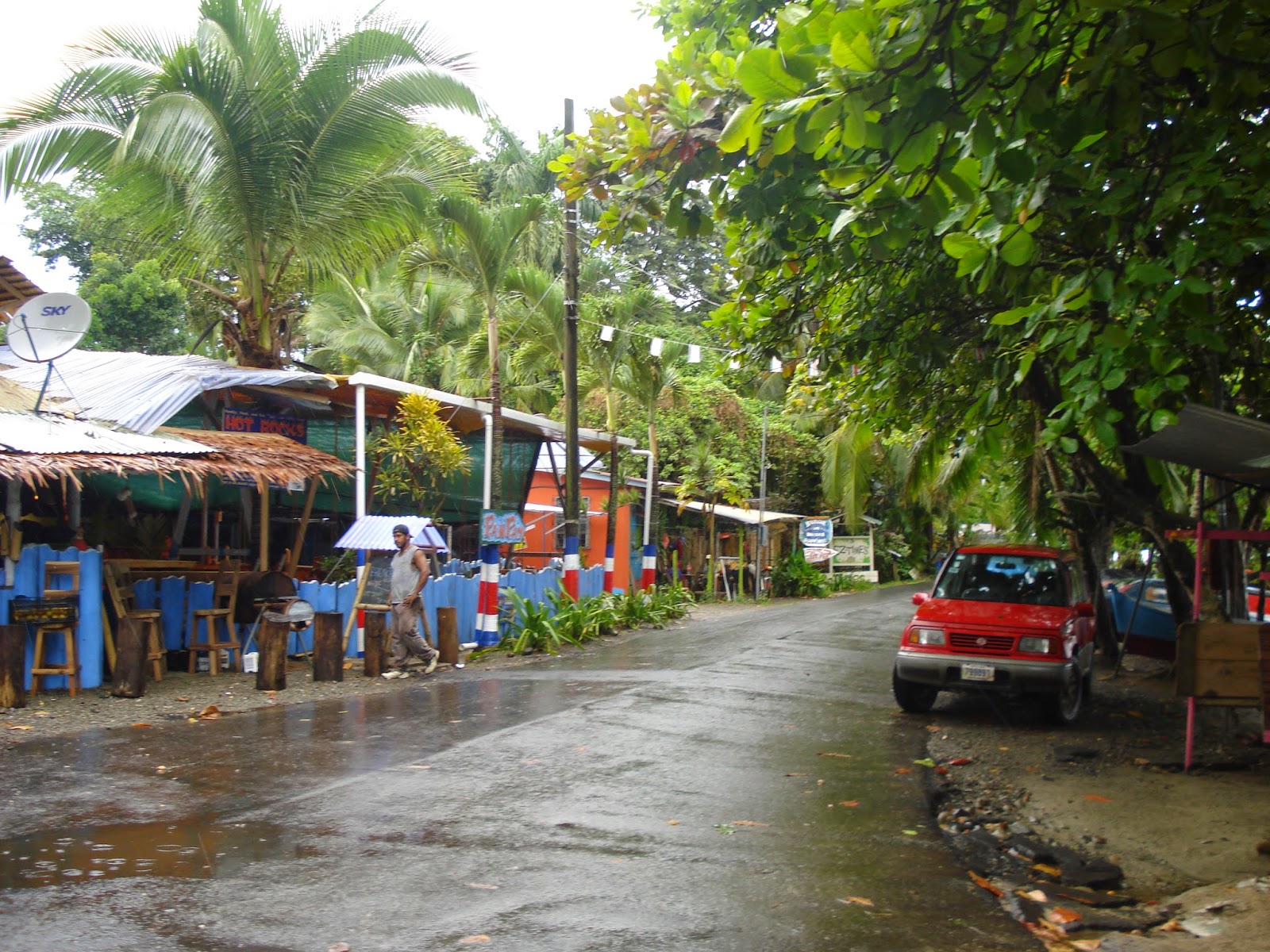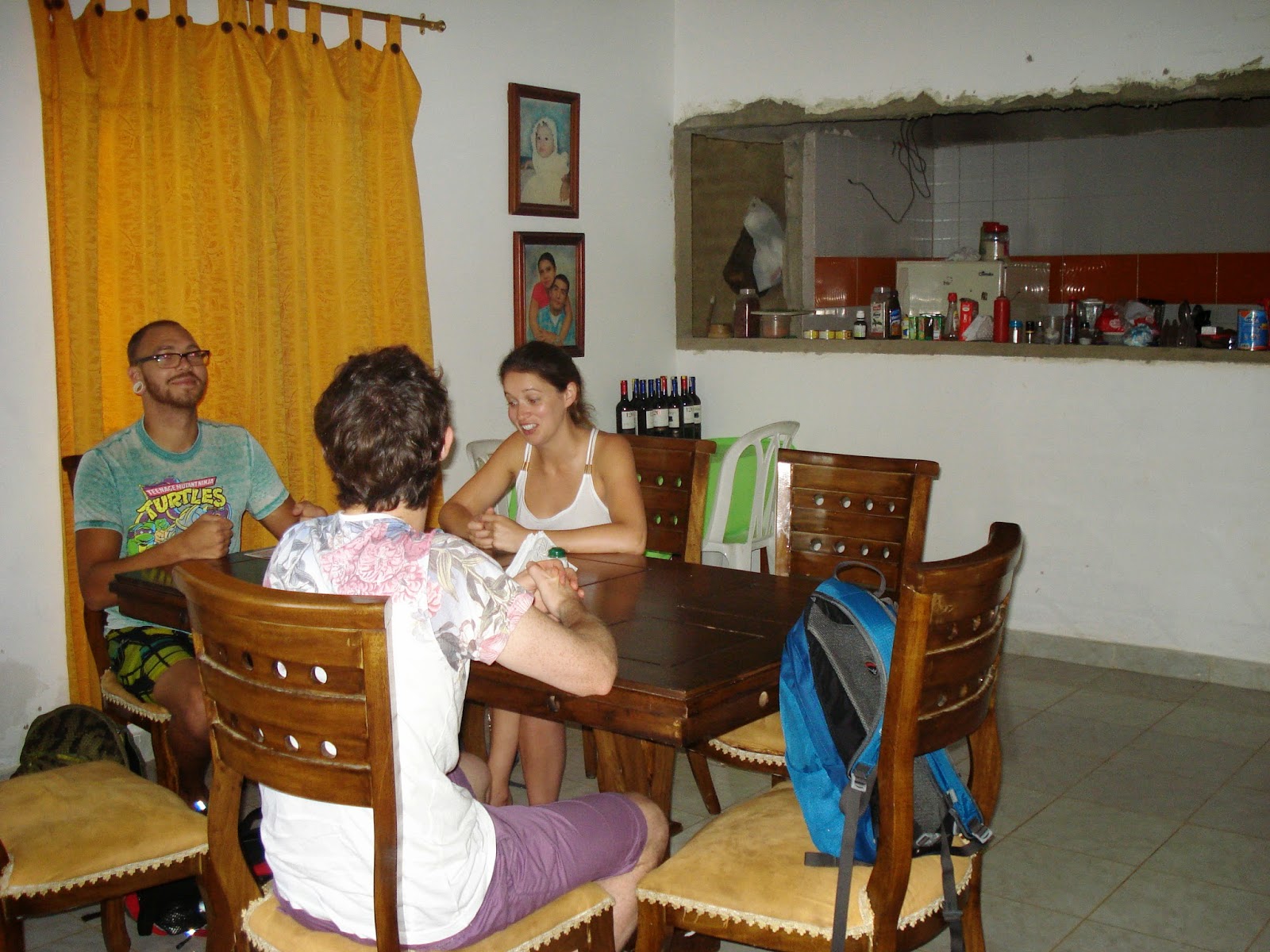Costa Rica
October 12 - 18
October 12 - 18
On the morning that we left Uvita, our host's parting words to us were to 'stop banging pots and pans in the kitchen' because we'd woken her up. Aw, we'll miss you too, angry German lady. And with that, we were off! We walked for the last time down the jagged dirt road to town, said goodbye to the sloth sleeping in a tree on the corner, hustled with Nancy the tour guide to the bus station. Only eight hours and one bus change later, we made it to...
Puerto Viejo
When we rolled into Puerto Viejo at about four o'clock and stepped off the bus, we were surrounded immediately by taxi drivers asking where they could drive us, which was funny when we realized that the whole town covered like half a square mile. Puerto Viejo is a small Rastafarian beach town, full of Bob Marley cover bands and locals selling weed to tourists, and where every restaurant, every day, likes to proclaim on exuberant sandwich boards that their "catch of the day" is red snapper. Get it while they've got it, guys! This rare breed goes fast!
As we walked along with our conspicuous backpacks, we were followed by men on bicycles riding idly around and shouting at tourists, "Hey, hostel! You want a hostel!" and "guys, that place is full, come over to my place!" This is the part where we might have realized we're racist, because the first person we actually took a hostel recommendation from was a European girl with a less confrontational sales pitch:
"Would you two care for a hostel recommendation?"
So we followed her directions to La Ruka Hostel. On the way there she passed us again, this time leading a trail of gringos like a pasty Pied Piper to this place where, in fact, she ended up roping in TOO MANY takers. La Ruka had to awkwardly turn away backpackers who had followed this girl on her bike ten minutes past the edge of town.
Like we did, I'm sure all those people responded to her based on her ability to speak nuanced English, which of course made her sound friendly and less aggressive than someone just yelling "hostel!" over and over. Fair enough, and La Ruka was perfectly comfortable and a good place to meet other travelers. But here's the thing -- travelers will choose these hostels run by other foreigners, and then grumble about getting ripped off by locals when they want to buy things around town. But why should locals be expected to cut you a fair deal when you're staying at a foreigner's hotel and speaking blunt, imperfect Spanish that probably sounds just as abrasive as shouting "hostel!" does?
I dunno, just my two pennies.
ALSO, when we asked the front desk attendant for a restaurant recommendation, she responded, "oh I don't know, I've only been working here ten days." Ten days?? A week and a half?? You don't know one place to eat??? Get it together!
 |
| Admittedly not the best picture I could have taken of Puerto Viejo |
"Would you two care for a hostel recommendation?"
So we followed her directions to La Ruka Hostel. On the way there she passed us again, this time leading a trail of gringos like a pasty Pied Piper to this place where, in fact, she ended up roping in TOO MANY takers. La Ruka had to awkwardly turn away backpackers who had followed this girl on her bike ten minutes past the edge of town.
Like we did, I'm sure all those people responded to her based on her ability to speak nuanced English, which of course made her sound friendly and less aggressive than someone just yelling "hostel!" over and over. Fair enough, and La Ruka was perfectly comfortable and a good place to meet other travelers. But here's the thing -- travelers will choose these hostels run by other foreigners, and then grumble about getting ripped off by locals when they want to buy things around town. But why should locals be expected to cut you a fair deal when you're staying at a foreigner's hotel and speaking blunt, imperfect Spanish that probably sounds just as abrasive as shouting "hostel!" does?
I dunno, just my two pennies.
ALSO, when we asked the front desk attendant for a restaurant recommendation, she responded, "oh I don't know, I've only been working here ten days." Ten days?? A week and a half?? You don't know one place to eat??? Get it together!
In the morning we walked to the Jaguar Refuge, which is fantastic. This place is a wildlife refuge, where they take in animals who have lost limbs, incurred brain damage or been machete-ed to the head, among other weird accidents that tend to happen around machetes. While we were waiting at the front for the tour to start, we watched sloths climbing through the trees in their little courtyard, and repeatedly falling into the bushes below them. They have volunteer care-takers, whose jobs are simply to watch the sloths and retrieve them when they fall out of their trees.
 |
| A sloth who has fallen into the bushes |
The other volunteer jobs at the Jaguar Refuge Center involve cuddling with recovering monkeys, ocelots and anteaters, while tour groups filter through and watch. One guy was sitting in the corner of a monkey pen, his half-buttoned shirt stuffed with sleeping monkeys, their butts poking out from under the hem. So adorable, I spent the entire tour squealing with glee. Here are some cute animals!
The refuge, after they have determined an animal to be sufficiently recuperated, sets them free in the jungle right behind the open premises, so that the animals can leave, but can always come back if they need food. So mid-tour this orange, mangy looking, four foot monkey with visible healed wounds came swinging around the side of a building and just loped right into our tour group, grinning at the crowd like a crazed hobo. He scared the absolute crap out of a little girl, who then started sobbing. It was just a perfect, perfect moment. Why do I never have my GoPro when I need it! #newyearsresolution
 |
| A monkey swings over to terrorize children and collect his food rations |
At one point they let us into a room to play with the monkeys, who, it turns out, take a keen interest in ear-wear, because they were all over Eian -- grabbing his ears, jumping on his head, swinging into his face. Just a majestic interaction between man and wild.
The next day we hit the road again, this time into the mountains to La Fortuna.
The next day we hit the road again, this time into the mountains to La Fortuna.
La Fortuna
We stayed at the self-described "Famous Arenal Hostel Resort," which made us wear lame tourist wrist-bands and is named for the most active volcano in Costa Rica, Arenal. We did not climb that one. Because it's illegal. But we did hike Cerro Chato, a dormant volcano whose top caved in and created a lake at the top.
 |
| Arenal Volcano from afar |
As our tour group of five young able-bodied adults in our mid-twenties made our labored way to the top, we met a man in his sixties skipping down toward us who, baffled by our red faces and pit-sweat, said, "oh come on, guys, it's only a hill." He was from Switzerland, and according to our guide, the Swiss bound up these volcanoes like gravity ain't even a THING. Get it, Swiss.
 |
| Just follow Eian, he knows the way! |
 |
| We climbed underneath that waterfall! |
Because we backpackers love nothing more than navel-gazing discussions of the differences between our respective countries, we got onto the subject of going through customs and immigration at airports. Our guide said that on a trip to Europe once, which included a layover in the United States, he was taken to a private room for questioning by American customs officials, and was asked:
- Are you a terrorist?
- You're planning to kill the president of the United States, aren't you?
- You're planning to kill the president of the United States, aren't you?
The other people on our tour, who were British, said they had been asked the same questions when traveling, not even to America, but through it. I love it. What are we expecting in response to those questions, exactly? Yes? "Ahhh, you got me! I should have anticipated that American questioning techniques would be too cunning for the likes of me!" Forehead slap. It must happen though, right?
Also in La Fortuna was a little waterfall and rope swing nick-named "El Salto" (the jump), where a group of Ticos were jumping and doing tricks and having a blast. We thought we'd hit upon a very authentic local hangout spot, and then we noticed their garish tourist wrist-bands that looked exactly like our own. OH. Nope, we were still tourists palling around with other tourists, albeit Costa Rican ones, so I think we can still collect some points for that. They were from San Jose, and gave us an opportunity to practice our new Costa Rican slang, "tuanis," which is like saying "cool" or "sweet." It comes from saying "too nice" in English. The more you know! Practice it at home and you too can speak like a native Costa Rican!
 |
| Merman Lagoon |
 |
| Me, demonstrating a perfect ten-point landing |
Thus concluded our visit to La Fortuna, which as a town we actually really enjoyed, despite everyone telling us it was really touristy and overpriced. Honestly, of everywhere we went in Costa Rica, we found more reasonably priced local food in La Fortuna, and our 'resort' hostel was only $10 a night, which, for Costa Rica is some bargain basement prices. As for "too touristy," all of Costa Rica is touristy, and, like pervasive mold in a humid shed in the jungle, cannot be escaped. As our Tico mountain-guide told us when we mentioned the high prices, "you made us this way."
Before we got down to Central America, our actual plan for this trip was to stay in Costa Rica doing work exchanges for about six weeks, which, in light of how much fun we've had in every country since Costa Rica, and how much more we've been able to experience for the money, is downright embarrassing. This is not to say we did not have a great time in Costa Rica, because we did, with even a couple of stand out high points for the whole trip. But it is to say -- and this is controversial, try not to riot in the streets over it -- that Costa Rica, just maybe, is a tad overhyped. It is a spectacular and beautiful place, but...so are the less talked-about countries on either side of it.
And so, on to Nicaragua! Let's lose track of time a little bit, NICA STYLE. For real, two weeks blew by and we were like, "bwuh? How did we let this happen? Why are we still on this beach? And why are our chicken and patacones still not ready? We ordered those two days ago. People sure do take a while to fire up their grills here."
Verbatim though, that's what we said.
Thrilling details to follow!








































